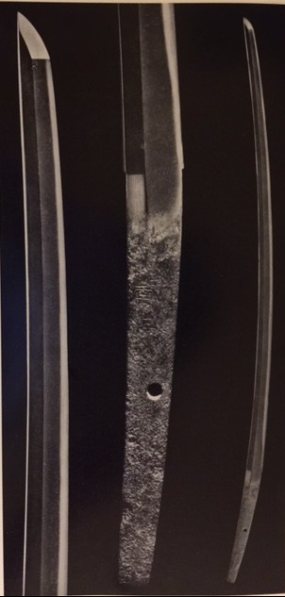This chapter is a detailed part of chapter 14| Late Kamakura Period Sword. Please read chapter 14 before reading this section.

The red circle above indicates the time we discuss in this section.

In Chapter 14| Late Kamakura Period: Sword (鎌倉末太刀), the Ikubi-kissakui sword was explained. The above illustration shows a flaw that was caused when the damaged area was repaired. To compensate for this flaw, swordsmiths started a new sword style in the late Kamakura period. They forged swords with a longer Kissaki and stopped the tip of Hi at a lower point than the Yokote line. This way, if the Yokote line was lowered when it was repaired, the tip of Hi would stay lower than the Yokote-line.


The above photo is a sword by Goro Nyudo Masamune (五郎入道正宗 ). Please look at the size and shape of the Kissaki. This is different from previous Ikubi-kissaki, or Ko-gissaki. This is a typical late Kamakura period Kissaki style. This is O-suriage (largely shortened).
Under Kamakura Bakufu, many swordsmiths moved to Kamakura. They were Toroku Sakon Kunituna (藤六左近国綱) of Yamashiro Awataguchi group (山城粟田口), Fukuoka Ichimonji Sukezane (福岡一文字助真), and Kunimune (国宗) from the Bizen area. They were the origin of Soshu Den (相州伝). Eventually, Tosaburo Yukimitsu (藤三郎行光) and his famous son, Masamune (正宗), appeared. In the drawing above, Kinsuji and Inazuma are shown inside the Hamon. The shinning lines inside the Hamon are Inazuma and Kinsuji. Inazuma and Kinsuji are a collection of Nie. Masamune is famous for Inazuma and Kinsuji. Masamune lived in Kamakura; his Hamon looks like ocean waves when it is viewed sideways.


The above picture is a sword by a swordsmith of Yoshioka Ichimonji group (吉岡一文字). The Kissaki is also like the one of Masamune’s. It is longer than the previous Ikubi-kissaki or Ko-gissaki. This is Chu-gissaki. The Kissaki like this is one of the crucial points to determine what period the sword was made. The Hamon has Choji, Gunome, Togariba (pointed-tip), and very tight Nie.


The above photo is a sword by Ukai Unsho (鵜飼雲生) of Bizen Den. This sword is also from the late Kamakura period. But it has Ko-gissaki. This sword does not have the late Kamakura period Chu-gissaki style. Narrow Hoso-suguha is somewhat like an earlier time than the late Kamakura period. This sword indicates that the sword does not always have the style of that period. To Kantei*, first, look at the style and shape then give yourself some idea of the period of the time it was made. But in this case, Kissaki does not indicate the late Kamakura period. The next thing is to look at the different characteristics of the sword one by one like Hamon, Nie or Nioi, Jihada, etc., and determine what period, which Den, which province and then come up with the name. This process is called Kantei.
*Kantei — to determine the swordsmith’s name by analyzing the sword characteristic without seeing the Mei (inscribed swordsmith name). Mei may be gone if it was shortened.
All the photos above are from Sano Museum Catalogue. Permission to use is granted.